
Writer: Tom King
Art: Bilquis Evely
Colour by Matheus Lopes
Publisher: DC
It’s Supergirl like you’ve never seen her before, in a character-defining sci-fi/fantasy masterpiece from Mister Miracle writer Tom King and Wonder Woman artist Bilquis Evely.
Kara Zor-El has seen some epic adventures over the years, but she now finds her life without meaning or purpose. Here she is, a young woman who saw her planet destroyed and was sent to Earth to protect a baby cousin who ended up not needing her. What was it all for? Wherever she goes, people only see her through the lens of Superman’s fame.
Just when Supergirl thinks she’s had enough, everything changes. An alien girl seeks her out for a vicious mission. Her world has been destroyed, and the bad guys responsible are still out there. She wants revenge, and if Supergirl doesn’t help her, she’ll do it herself, whatever the cost. Now a Kryptonian, a dog, and an angry, heartbroken child head out into space on a journey that will shake them to their very core.
One of NYPL’s Best Books for Adults 2022, this volume collects Supergirl: Woman of Tomorrow #1-8.
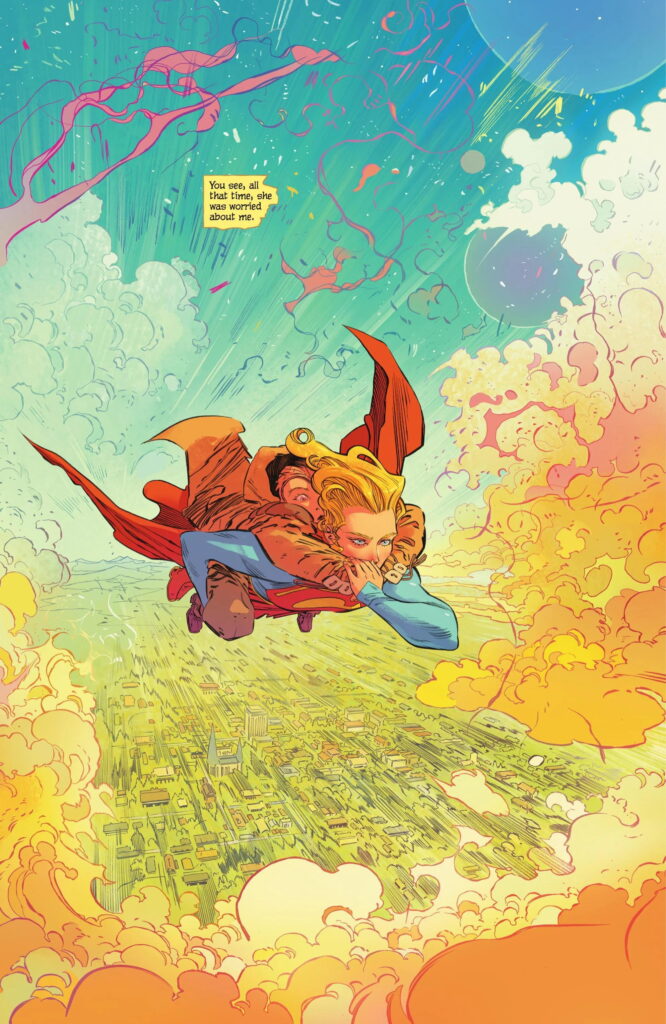
Review by Steven Sharpe
Supergirl: Woman of Tomorrow collects an eight-issue mini-series first published in 2022, which took the character away from regular DC continuity and placed her on a planet in the far reaches of space. It has some wonderful art and writing but isn’t without flaws, some of which feel self-inflicted. The recently proposed movie adaptation will earn the book recognition that, thanks to a character who has always been a little anaemic, could have left it an underappreciated gem.
It’s strange that after over 60 years since her introduction, it still feels like we’re getting to know Kara Zor-El. For such a reasonably well-known icon (one movie and six seasons of a TV show so far), Supergirl has had a precarious existence in comics; it’s as if DC haven’t really been sure what to do with a phenomenally powered teenaged girl.
In 1958, DC editors wanted to test fan reaction to a female version of Superman with a story where Jimmy Olsen uses a magic totem to wish for a helper for Superman. Super-Girl pops into existence in Superman #123 and, while the partnership isn’t particularly harmonious, DC probably hedging their bets and not wanting to overshadow the leading man, she dies protecting Superman from a chunk of Kryptonite.
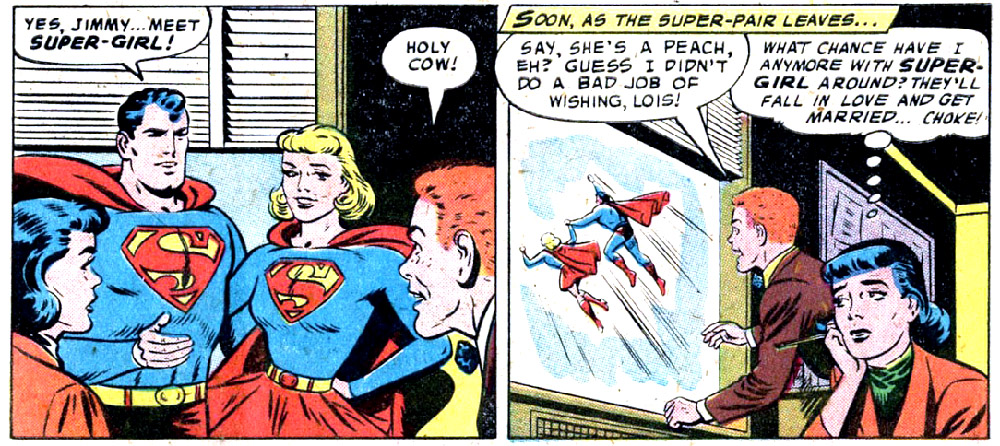
Fan reaction was positive enough to launch a proper version of the idea, dispensing with the hyphen to distinguish between the two versions. Kara Zor-El was created by Otto Binder and Al Plastino in 1959, the end of the Golden Age of comics, in Action Comics #252. She was the cousin of Superman and her sudden appearance as a teen was explained in a back story that involved refugees from Krypton travelling on a section of a city which had been protected with a shield. While they began a decade-long journey to Earth to catch up with Superman, Kara was born and grew into teenagerhood.
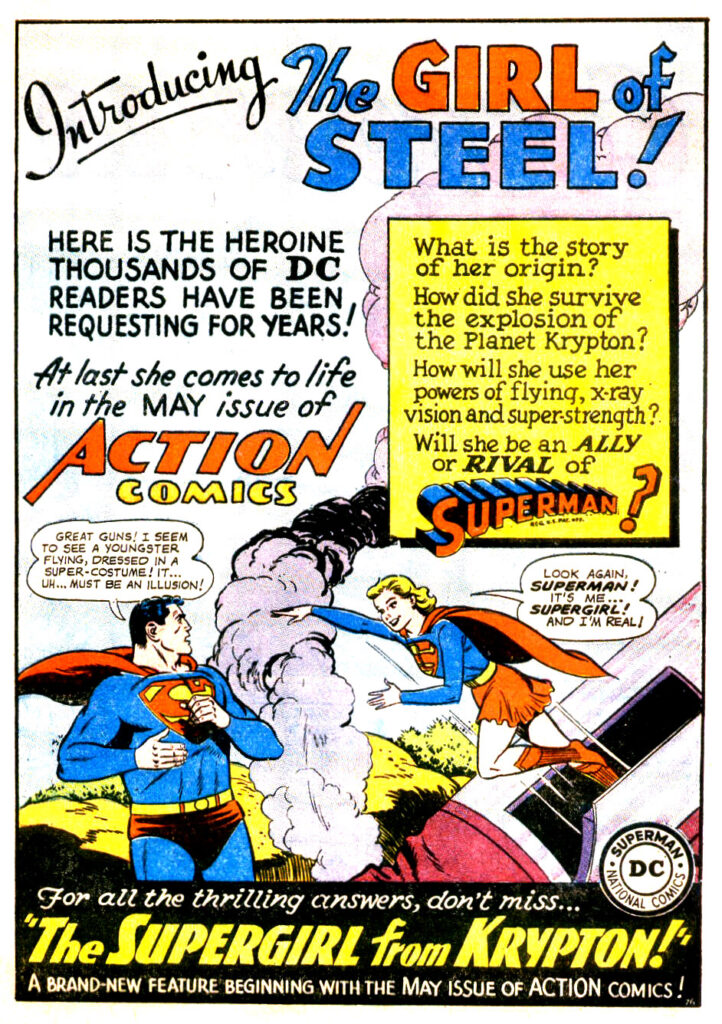
When a deranged civilian of the city sabotaged the rocket system that was propelling it, the structure was catastrophically damaged by meteorites and infected with poisonous green Kryptonite radiation. There was only time and resources to save Kara by sending her to Earth in a small ship.
As was typical of the time, Kara adopted a secret identity, Linda Lee, but Superman insisted that she also operate as Supergirl in secret until he was sure that she was mature enough and capable enough to use her powers wisely.
Perhaps all this secrecy had a destabilising affect on Kara, because she went through a series of jobs including student guidance councillor, news reporter (of course), and an actress in a soap opera. You could say that it reflected a time when there were less job opportunities for women. But, while superheroes usually go through subtle or not-so subtle changes in their personality to keep them relevant, their age tends to remain a constant, and establishing a character as a young adult means that their stories will often be about them discovering their identity.
In 1985 in the classic continuity-setting series Crisis On Infinite Earths, Supergirl was not only killed but wiped from everyone’s memory. The intention was to enhance Superman’s status as the last survivor of Krypton, so Kara was sacrificed (making the first test appearance of Super-Girl in 1958 and her sacrifice for Superman something of an omen). However, recognising the need to have a version of Supergirl in the DC universe, a super-powered being named Matrix, a man-made lifeform of synthetic protoplasm, took the role.
Hmmm.
In 1996, the character was merged with a human named Linda Danvers, which rubbed salt into the mortal wounding of Kara considering her secret identity had been Linda Lee Danvers. This new version was also a blonde young adult, although she did wear a different costume than the original Supergirl.
It wasn’t until 2004, in the DC event story Infinite Crisis, when the memory of Kara Zor-El finally surfaced for some characters and she appeared as Supergirl, albeit in the 31st century-set Legion of Superheroes. In 2011, another DC reboot entitled The New 52 saw Kara crash-land in a rocket-ship, as if for the first time. She’s still a young adult, finding her place in the world/universe with the near-invincible powers of Superman, but the modern twist is that the destruction of Krypton has left a scar on her personality.
So that’s why, after over sixty years since her introduction, Kara Zor-El doesn’t quite feel like an established character and she’s certainly in need of a character-defining graphic novel.
Enter Tom King. Aside from when he took a break from interning at Marvel, assisting Chris Claremont, to work in counterterrorism at the CIA, King’s ascent in comics has been by the book. He wrote single issues and one-shots at DC, and a creator-owned series under the Vertigo banner, before making a name for himself writing the Eisner Award-winning series The Vision (2016) for Marvel. DC locked him into an exclusive contract after that, where he continued to write shorter stints, but notably wrote a well-received Mister Miracle (2019) 12-issue series. Since then he has faired better writing standalone series (Strange Adventures, Human Target, Rorschach), rather than the decidedly mixed reactions on his run on nearly ninety issues of Batman, where King proved that he’s not afraid of making controversial choices, including killing Alfred.
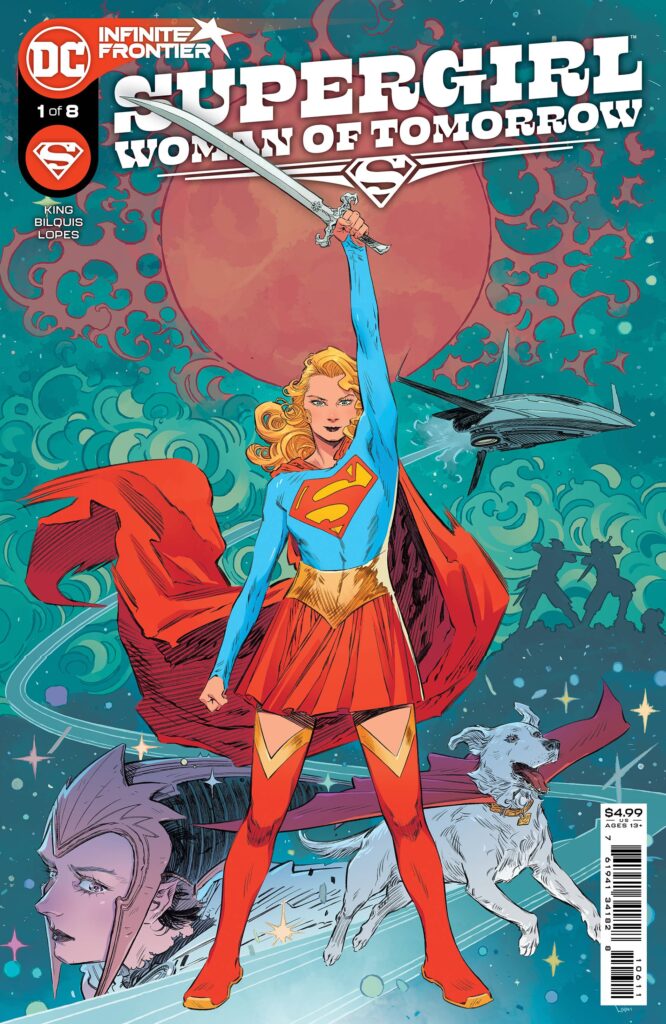
King’s first interesting storytelling choice for Supergirl: Woman of Tomorrow is to not put Supergirl at the centre of the story. The real focus is on Ruthye Marye Knoll from a far-off, technologically backward planet. It’s she who narrates the tale from many years after the events in the book. (This isn’t a spoiler, it’s revealed very quickly). We’re even told, in very broad terms, how the tale will end. It serves to heighten the feeling of watching a legendary story unfold. Like Star Wars adding gravitas by letting us know that the story happened a long time ago in a galaxy far, far away.
The catalyst for the tale is the murder of Ruthye’s father, and her vow to find the murderer and slay him with his own sword, which was left in her father’s corpse. Ruthye is barely a teen and needs the services of a warrior to help track the killer. After being betrayed and threatened by the first person she turns to, Supergirl steps in to save her. I say steps in, but in this first time we meet Supergirl she is drunk and barely cognisant.
The reason Supergirl is drunk is that she has just turned 21, and has travelled to a planet without a red sun, so that she can feel the full effects of alcohol. It’s a cute idea. In terms of plotting, we have the reason for Kara and Ruthye meeting; dramatically, we know that Supergirl is in a weakened state and newer readers have been reminded about the influence of the sun; and in terms of character, Kara is doing something relatable for a person her age. Plus, seeing someone get drunk in a solitary way rings little alarm bells that they’re drinking to console themselves.

When Kara sobers up the next morning, Ruthye asks her to help her with a quest, but she refuses. Supergirl getting drunk!? Refusing to help a girl who’s lost her father!? Is there a new, surly edge to this young adult? Tom King takes it further by having Kara swear frequently throughout the book. It jars a little against the saintly reputation of the Super Family, and I wondered whether it was an overly self-conscious decision to make her cool. But it’s an interesting contrast to the language of the younger Ruthye who is almost implausibly well spoken.
As Ruthye makes an impassioned plea about the loss of her father, Supergirl becomes moved, because it’s striking a personal chord of loss. “I lost my world!” says Ruthye. With tears in her eyes Supergirl turns away and says “I came here on my $@$%#&% birthday so I wouldn’t have to always think about -”. She’s cut off when Krem, the killer of Ruthye’s father who’s heard of the girl’s intention for revenge, ambushes them. With his bow and arrow, he not only shoots Supergirl several times (remember, Kara is weakened), but also seriously injures Krypto, Kara’s super-powered dog. Krem then escapes in Supergirl’s ship.
Yes, Krypto the Superdog, that curious symbol of the Golden Age of comics, has come along for the ride too, complete with the signature red cape. Another of Tom King’s interesting choices. Supergirl tells Ruthye that Krypto has been poisoned and that she needs to find Krem to discover what poison has been used so that an antidote can be prepared. And so both Kara and Ruthye set off across the galaxy in search of the killer with the question of whether revenge can ever be justified hanging in the air.
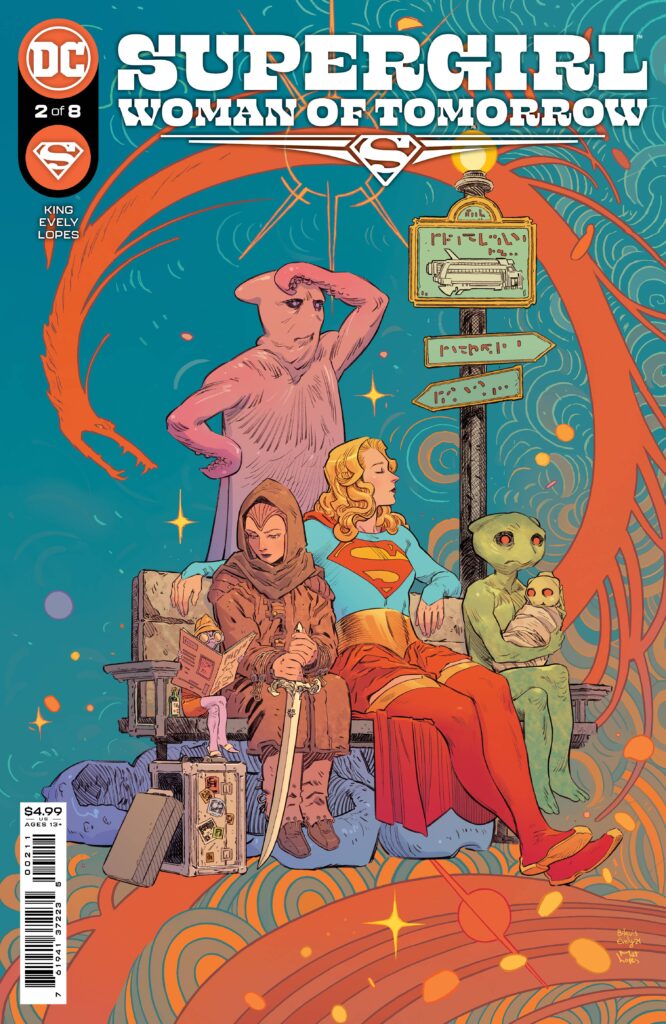
Each chapter rolls by in a different setting or planet, like True Grit mixed with The Ballad of Halo Jones, and each end with the closing of a narrative arc. The episodic nature of the story works well, accentuating the feeling of an epic saga that we’re only witnessing the highlights of. Often, the credits often play out in the final panels of the chapter in the aftermath of the climax. It’s a device that adds poignancy to closing moments in a way that Warren Ellis would use on titles such as Planetary and Global Frequency, which featured single-issue stories.
The second chapter takes a slower pace than the story-setting previous one and allows us to see the differences between the two central characters. Ruthye is as verbose as a child as she is an elderly narrator, as well as serious and focused. Because the story is told from Ruthye’s perspective, Kara is seen as enigmatic, which makes her intriguing to both Ruthye and therefore the reader. She seems to be a little more in the moment, more accepting. But it comes with a hint of jaded nihilism. When faced with a dragon attacking the passenger ship she’s on, the captain tells her “We’re all going to die”. Kara simply says, “Bummer.”
In contrast to Ruthye’s dialogue, responses such as this, and her frequent swearing, make Kara seem like a cynical teen. But there’s more depth than that. It’s counterbalanced by a scene where Kara teaches Ruthye (who has grown up in a harsh environment on a farm) how to wash her hands thoroughly. It’s a moment of connection, both physically and emotionally. Teaching someone to wash their hands is a rudimentary act replicated by parents with their children and Kara can’t help but mention her mother, briefly demonstrating as she falters that it is still an unprocessed loss.
We’re now at the heart of the matter to the story and it leads to an important moment when Ruthye asks Kara if she sought revenge for the death of her home world. It’s rare that the tone of voice is conveyed in comics other than in the lettering, but as Ruthye describes the moment it allows Kara’s response of “No. I didn’t” more weight when Ruthye says that the tone carried “a whole life of regret.”

In chapter three, Supergirl and Ruthye discover that Krem has joined a group called the Brigands, a bloodthirsty race who cut a bloody swath across space, visiting worlds only to commit genocide and plunder their resources. If Kara’s relationship with Ruthye has picked at an old wound, their experiences of the devastation left behind by the Brigand begins to eat away at her grief and eventually opens a doorway to anger. In particular, the fourth chapter depicts, heartbreakingly, the effects of merciless slaughter effectively. When Supergirl watches a recording of the slaughter off-page and out of sight of our narrator, she returns looking stoic, but it’s easy to feel the impact it’s had on her. Afterwards, in a brilliant moment of understatement, Kara and Ruthye watch as a captured Brigander is stoned to death. “I know he surely deserved his fate,” says Ruthye, “But I had some thought that you’d save him.” Supergirl replies with, “Did you?”
For anyone envisioning an ending where Krem is captured and Supergirl stops Ruthye from killing him to teach her the difference between justice and revenge, Kara’s slowly building anger is beginning to raise doubts. The simple story is beginning to complicate as the character develops. Indeed, Supergirl: Woman of Tomorrow has wonderful examples of Tom King’s strengths as a writer in his instincts towards the character, development of themes, and his dialogue. When he introduces the theme of segregation due to racism on one planet, he then takes it further by presenting the dominant race the dilemma of either allowing just the subjugated race to be slaughtered by the Brigand or for the whole population to die. They choose the first option, and are left with genocide on their conscience. A scene where Supergirl is forced to take a nervous Ruthye flying with her, she says with touching simplicity, “I’m going to hold my hands here. And these hands can turn coal into diamonds, so they’re not going to let go.” I loved lines such as “In the practice of magic, rules slip through your fingers as often as the devil slips over your tongue.”

Anyone who’s read The Vision will have seen evidence of King’s handling of language – the problem sometimes comes from wishing he would exercise a little more restraint. In a sequence where bullets are suddenly fired into Kara and Ruthye’s bedroom, three nicely illustrated panels close in on Ruthye as Supergirl shields her. Despite the fact that it’s a moment that has increased the drama and action of the chapter, King slows down the pace with Ruthye’s narration as she recounts a memory of her mother which formed her feelings towards death. In the flowery language, King uses a word I had to look up (vicissitude, a change of circumstances or fortune, typically one that is unwelcome or unpleasant). One part of my brain was having to slow down to absorb the side-track, one part wanted to take in the art, while the other was desperate to turn the page. And of course, me being me, I had to look up the unfamiliar word. All over three panels of action.
King’s determination to prove Ruthye’s eloquence can challenge plausibility. How many kids would say the line “Am I not a young child out of her depth in a sea of violence and despair?”.
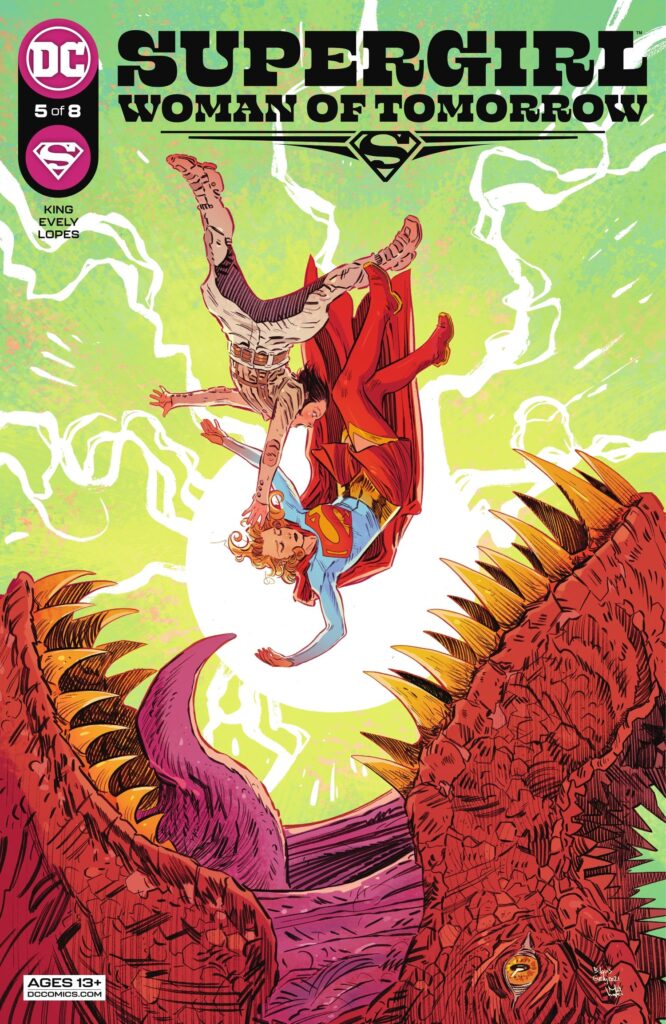
In the fifth chapter Supergirl and Ruthye are stranded on planet Barenton, a world designed with the purpose of punishing Superman, complete with a green sun and monsters. We’re reminded that when he was there Superman had to be rescued by the JLA and his 45 minutes there is described as “the most painful experience…And the closest to death he ever got.” Kara is forced to survive for ten hours with Ruthye looking after her. It’s a brilliant way of demonstrating Supergirl’s endurance and Ruthye’s fortitude and bravery defending her. But when one monster attacks and all Ruthye has is a sword, she first tries to ward off the dinosaur-like monster with long-winded threats.
I have a sneaky suspicion that Tom King needs a strong artist on his projects. Every writer benefits from a good artist of course, but in King’s case it’s not to make up for deficiencies, but because there’s a feeling that he’s reaching for something grander in his comics and without the artistic equal to those plans he’d be metaphorically left hanging. If the sequence with the bullet-fire had been illustrated in any lesser way, it would’ve left the writing as the focus and sounding pretentious.
I’m happy to say that in Supergirl: Woman of Tomorrow, the artwork is fantastic. Illustrator Bilquis Evely is adept not only at sequential storytelling and conveying character, but also world-building, fusing all the elements of science fiction and fantasy in the story. Every panel is filled with delicate, detailed linework which is always expressive. The combination of Evely and colourist Matheus Lopes manages to make each location, each alien race feel unique and also part of the same universe. Even the skies feel alive. For the art alone, I feel that the series was woefully under-looked at the 2022 Eisner awards, receiving only one nomination which was for Best Limited Series.
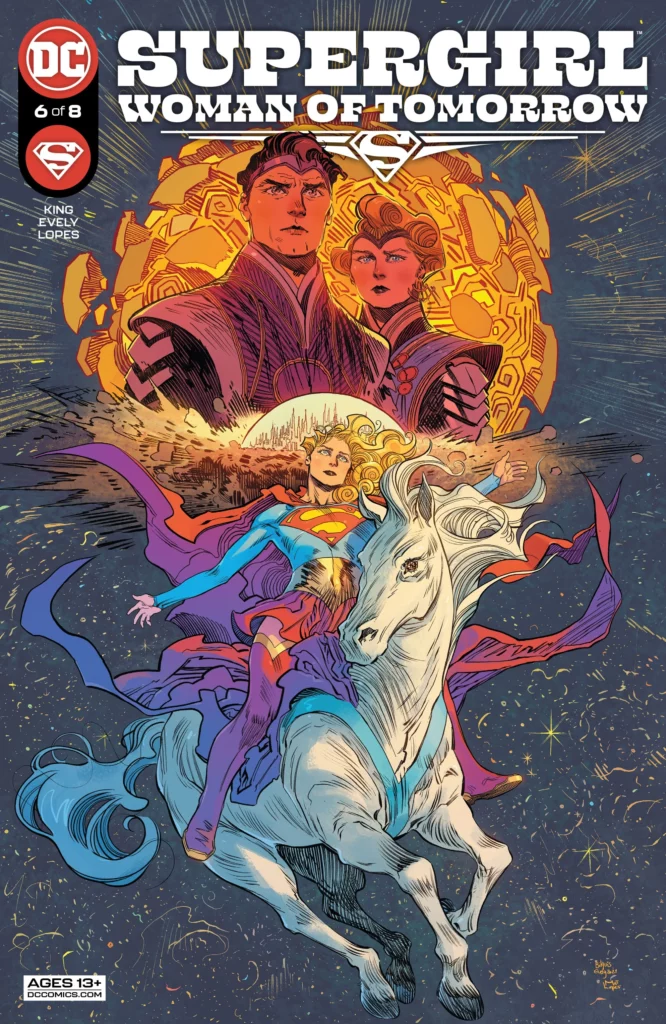
The sixth chapter is an example of how Tom King shows ambition in his storytelling and relies on the broad shoulders of Bilquis Evely. Once again, Ruthye’s narration tells a story at the same time as important events unfold in the main plot – this time both are crucial. At the beginning, Supergirl catches up with Krem who unleashes an indestructible weapon that chases her. As she races across the space, Ruthye recounts the story of Supergirl’s origin. King amps up the dramatic importance as Ruthye tells us that Kara told her for the first and last time. “I’m sure you’ve heard it,” Ruthye says. “But you didn’t ever hear it from her.”
Kara’s journey, it turns out, was filled with tragedy and personal fortitude. She was already a teenager during the destruction of Krypton and not only bore witness to the death and devastation before the evacuation, but she suffered the slow decline and death of her mother on the floating city. She was then at the forefront of rebuilding work to defend the city against radiation until, when all was lost, she said goodbye to her father as he sent her to Earth in an escape pod. At least Superman was protected from the trauma by being a baby during his version of events. It’s a lot of dramatic ground to cover especially as it’s intercut with images of spectacular fantasy, heightened by King’s choice of transport for Supergirl is Comet, the Super-Horse.
That’s right, first Krypto and now Comet representing that bygone era of Supergirl, dropped into the story whilst describing the tragic events that brought her to Earth. It’s as if King is trying to unify all the elements of Supergirl; the innocence of the Silver Age, mixed with the modern era of characters being shaped by trauma. And Bilquis Evely makes it magnificent. Somehow, Evely and Lopes keep the style and tone consistent so that even if you flick through the pages of the chapter, the contrasting narratives look seamless. The beautifully designed images of Comet hurtling through the stars look as if they are taken from a fairy story.
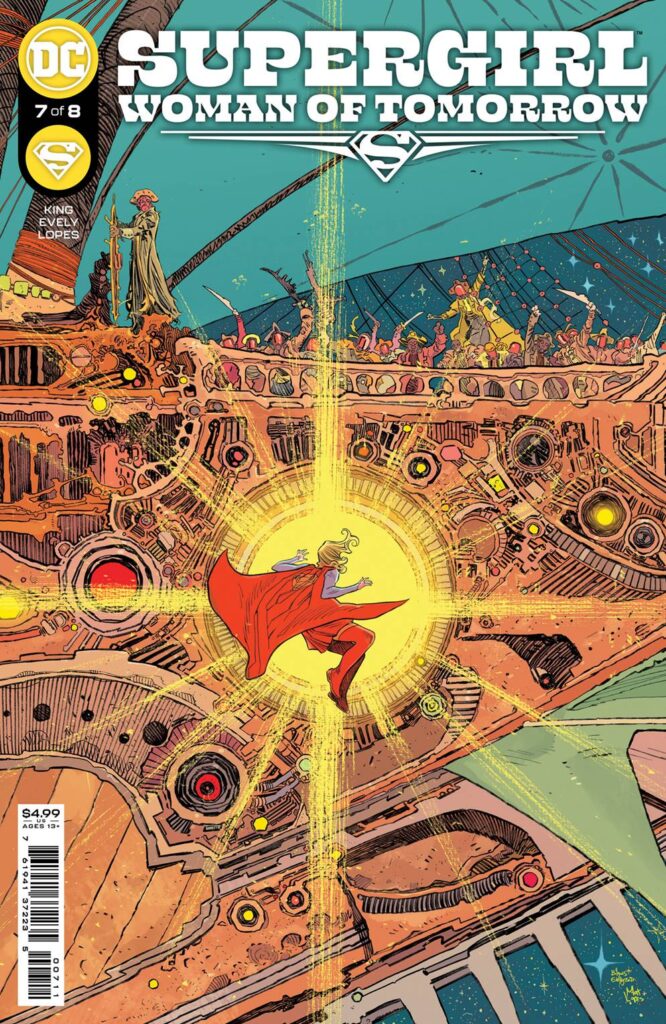
The final two chapters bring events to a resolution as the two young women catch up with their quarry, both Krem and the Brigand. Once again, King frustrates with deliberately intrusive writing. As Supergirl takes on the Brigands, the tension and pacing are undermined by Ruthye’s verbosity. With the young Ruthye talking in the same way that the older Ruthye narrates, her voice dominates the seventh chapter in particular. The temptation is to ignore parts of it and allow Evely’s sequential art to carry you through the pages. That said, the events are compelling, and I felt genuinely invested in the characters to the last page.
I have read negative comments by people who found the ending to be unsatisfying. I think that the theme doesn’t help. The issue of justified revenge is a universal question that can ultimately only be applied to each situation as it arrives. As a war between head and heart, the argument is never going to be fair, or entirely satisfactory.
There have also been questions of plausible character growth levelled against the story. In fiction, every good character has a dark half to wrestle with, and in superheroes it often takes the shape of a traumatic memory. The post New 52 re-introduction of Kara Zor-El gave us an angry and confused young woman who, for a while, was a threat as she acted out her grief and anger over the fate of her family and home world. Eventually, she calmed down and settled into her new home and her heroic responsibilities. But in this modern era of therapy and analysis, we know that trauma runs deep, can fester, and takes a long time to process and accept.

Tom King appears to have recognised this as an opportunity to bring depth to Supergirl. Rather than tell a story where she finally comes to terms with her past, and therefore exorcise her demons, he has used Supergirl: Woman of Tomorrow as a vehicle to bring definition to that trauma. He focused on Ruthye so as not to tell the story from Kara’s perspective, which means, by keeping her at arm’s length, he had an excuse not to complete the character arc usually expected in a story. This is a trick that every good comic writer has to get to grips with – these characters can only appear to develop and grow, otherwise you take away the parts of them that are interesting.
I feel like Supergirl now has a tentpole graphic novel under her belt. The art is a triumph, and the story cleverly includes the origins of the character whilst demonstrating that Kara Zor-El is heroic, brave and has depth. She feels like a character who originates from a different era of comics and deserves to endure for decades to come.
Steven Lee Sharpe
Steven has been writing his entire life. Aside from fiction, he writes graphic novel reviews and promotional posts on Instagram for Dave’s Comics bookshop in Brighton, plus news articles and comics reviews for Dark Knight News
• Supergirl – Woman of Tomorrow is available from all good book and comic shops – although seems in short supply at present! | ISBN: 978-1779515681 | Kindle edition available here from AmazonUK (Affiliate Link)
• Cosmic Teams – The Super-Women of the Silver Age
Smashing guide to the early super women of the DC Universe
One of many guest posts for downthetubes.
 In Review: Torpedo 1936 to Torpedo 1972
In Review: Torpedo 1936 to Torpedo 1972  In Review: Hawkeye Kate Bishop: Team Spirit
In Review: Hawkeye Kate Bishop: Team Spirit  In Review: Venom Volume Two – Deviation
In Review: Venom Volume Two – Deviation  In Review: Aquaman and the Lost Kingdom (2023)
In Review: Aquaman and the Lost Kingdom (2023)